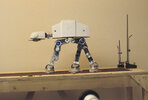Hagoth
Sr Member
About the pulley system moving the hydraulic pistons up and down in the upper leg... the metal skeleton picture shows a circular pulley type system inside the upper leg that seems to be connected by cables to the main leg and hip joint. I suspect this is connected to the hydraulic piston shells moving them up and down as the lag rotated in reference to the hip movement. So I think this is the precise repeatable movement Analyzer deduced with the quote. I have been thinking about what links might be needed and how to duplicate the motion automatically in my 3D printed project version. It will have as many automatically moving parts with leg motion as I can figure out.
You can see what I think is the pulley system here on the front leg that is missing the lower part.

Nice! That leg extension pivot point above is just what I was looking for. That tells me that it would be precise and repeatable as well and I think you are dead on Starks that this is a motion limiter. Also, because it provides three contact points including the hip pivot point that do not have a linear relationship to each other it might automatically help hold the leg in position once moved. Looks like the Cam could lock it. Clever! Now I want to duplicate it and make one myself to see the mechanics of it.
Definitely going to look up that book Chaïm. Thanks for the lead on it.
That animation is pretty darn good. I've seen that before but never paid really close attention to the actual individual movements of the various parts It is missing some of the relational movement we see on screen like the separation of the travel limiters (leg extensions) and the movement rates and timing are off to be tied to the repeatable pulley drive system mentioned. however, it shows well the majority of parts that have movement.
Really fun stuff here guys!
You can see what I think is the pulley system here on the front leg that is missing the lower part.

Nice! That leg extension pivot point above is just what I was looking for. That tells me that it would be precise and repeatable as well and I think you are dead on Starks that this is a motion limiter. Also, because it provides three contact points including the hip pivot point that do not have a linear relationship to each other it might automatically help hold the leg in position once moved. Looks like the Cam could lock it. Clever! Now I want to duplicate it and make one myself to see the mechanics of it.
Definitely going to look up that book Chaïm. Thanks for the lead on it.
That animation is pretty darn good. I've seen that before but never paid really close attention to the actual individual movements of the various parts It is missing some of the relational movement we see on screen like the separation of the travel limiters (leg extensions) and the movement rates and timing are off to be tied to the repeatable pulley drive system mentioned. however, it shows well the majority of parts that have movement.
Really fun stuff here guys!


